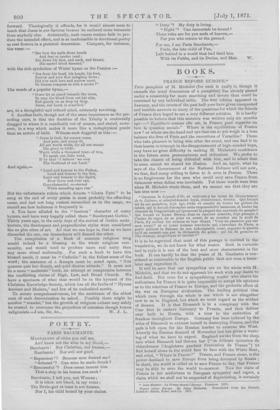ENGLISH HYMNS.
[TO TUN EDITOR OF rims " SPIDOTAT011.1 Sin,—I think that there are very few of your readers who have not felt unmixed pleasure at your article on "A Book of Common Praise," which so forcibly describes many of the chief faults of our present Hymnals, and shows us the direction in which our future efforts should tend. Let me, as a clergyman of the Church of England, point out what I deem to be some more of the striking errors in our present Hymnody.
1. The objective [9 external] character of so many of our hymns. Taking " Hymns Ancient and Modern " as a type (and, all things considered, it is the best hymnal we have), out of the sixteen hymns iu it for Easter nearly all of them speak of the physical resurrec- tion of the body of Christ, whilst the spiritual resurrection of the Christian is almost lost sight of. The same is true of the hymns for many of the Christian seasons, of those for -Bap- tism and of those for the Holy Communion. The facts which Christians believe, are doubtless worthy of being sung, and the plainer those facts are stated, the easier they are understood by the young and by the uneducated. But modern hymnody too often rests satisfied with this, as if the highest teaching of Easter was to prove a physical miracle, or that the lessons of Whitsuntide are at an end when the facts of the "fiery tongues and mighty wind" are believed in. It is true that in his earlier epistles St. Paul chiefly insists upon the resurrection of Christ as an historical fact, but in his matures writings he makea the spiritual resurrec- tion from death to life the central point of his theology. Madera hyinuody grasps the literal fact, and when it bas done this, radii contented.
2. Another failing, both in an artistic and a theological point of view, is the way in which the physical suffering of Christ is brought forward. Theologically it offends, for it would almost seem to teach that Jesus is our Saviour because he endured more torments than anybody else. Artistically, such coarse realism fails to pro- duce the intended effect, and is as inadmissible in devotional poetry as real flowers in a pictorial decoration. Compare, for instance, the verse :—
"Soo how the nails those hands And feet so tender rend ;
See down his face, and neck, and breast, his sacred blood descend," with the rich symbolism of Watts' hymn on the Passion :— " Soo from his head, his bands, his feet, Sorrow and love flow mingling down ; Did e'er such love and sorrow meet, Or thorns compose so rich a crown ?"
The words of a popular hymn,-
" Come lot us stand beneath the cross, So may the blood from out his side, Fall gently on us drop by drop. Jesus, our Lord, is crucified,"
are, to a thoughtful and refined mind, extremely revolting.
3. Another fault, though not of the same importance as the pre- ceding ones, is that the doctrine of the Trinity is continually dragged in where it is manifestly out of season, and stated, more- over, in a way which makes it more like a metaphysical puzzle than an article of faith. Witness such doggerel as this :-
" Jesus is God ; lot sorrow come,
And pain, and every ill, All are worth while, for all are moans His glory to fulfil ; Worth while a thousand years of woo, To speak one little word, If by that I believe we own The Godhead of our Lord."
"Laud and honour to the Father, Laud and honour to the Son, Laud and honour to the Spirit, Ever three and over one, Consubstantial, co-eternal While unending ages run."
But the unfortunate rubric which directs " Gloria Patri " to be sung at the end of every psalm is most probably the offending cause, and had not long custom reconciled us to the usage, we should see how ludicrous it frequently is.
4. You have alluded to the " luscious " character of many hymns, and have very happily called them "flamboyant Gothic." Thirty years ago, in the early days of the revival of Gothic archi- tecture, the flamboyant and perpendicular styles were considered
the ne plus ultra of art. All that we can hope is, that as wo have discarded the one, our descendants will discard the other.
The compilation of a Book of common religious song
would indeed be a blessing to the whole religious com- munity, and would tend to produce more real unity than any mere ritual uniformity. For such a book to have this blessed result, it must be " Catholic" in the fullest sense of the word ; the sentence of a Kempis must be acted upon, " Non quaeras quis hoc dixerit, sed quid dicatur attende." It must not be a mere " moderate " book, an attempt at compromise between the conflicting claims of High, Low, and Broad Church. We
have a specimen of what that would be in the hymnal of the Christian Knowledge Society, which has all the faults of " Hymns Ancient and Modern," and few of its undoubted merits.
To secure comprehensiveness, let the assistance of the ablest men of each denomination be asked. Possibly there might be another " scandal," but the growth of religious culture may safely be trusted to overcome the prejudices of mistaken though honest And again,—.



































 Previous page
Previous page